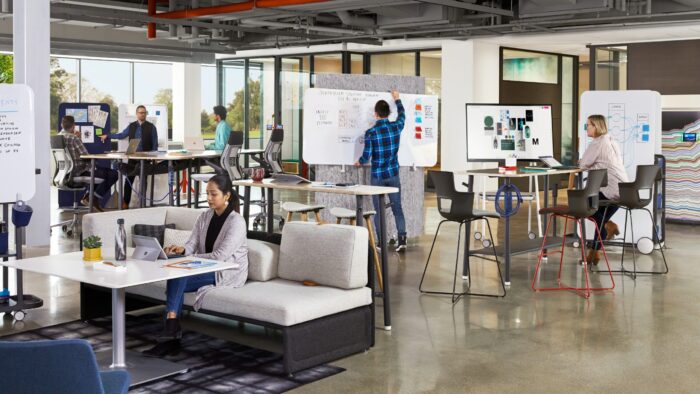Redesigning a commercial interior is never just about aesthetics. It’s about reinforcing your brand’s identity while creating a refreshed space that resonates with your values and vision.
Whether you’re revamping a retail store, a restaurant, or an office environment, maintaining a clear sense of who you are as a brand is essential.
When done right, an interior update can boost employee morale, elevate customer experience, and enhance functionality—all without compromising what your brand stands for. Here’s how to redesign with intention, ensuring your new look aligns perfectly with your established identity.
Understand Your Core Brand Elements
Before you begin selecting color palettes or replacing furniture, revisit your brand fundamentals. These include your mission, vision, core values, and the emotional tone your business conveys.
Is your brand minimalist and modern? Traditional and trustworthy? Bold and playful? These characteristics should guide every design decision.
For example, a company known for cutting-edge innovation might use sleek lines, tech-integrated furniture, and monochrome color schemes. Meanwhile, a heritage brand might retain rustic elements, warm tones, and textured materials.
Ask yourself:
- What do we want people to feel when they walk in?
- What makes our brand visually distinctive?
- Are there elements we must preserve to stay recognizable?
These answers will serve as your blueprint.
Audit What Already Works
You don’t need to throw everything out to achieve a meaningful redesign. Often, brands already have interior elements that reinforce their identity—logo displays, custom lighting, signature colors, or standout furniture.
Do an honest audit. What resonates with your team and your customers? What draws compliments or creates a memorable impression?
Preserving strong design features is not just cost-effective—it also helps maintain continuity. Even in a modernized space, familiar elements reassure loyal visitors and reinforce your branding.
Set Practical Goals for the Redesign
Updating interiors without a clear purpose can result in a disjointed and expensive project. Instead, start with practical goals. Do you need:
- Better customer flow?
- More collaborative spaces?
- Improved accessibility or compliance?
- Energy-efficient upgrades?
Define success. A restaurant might aim for faster turnover with better seating layouts, while an office may prioritize open-concept zones for hybrid work.
These goals prevent design decisions from becoming purely aesthetic and help you measure return on investment.
Keep Your Color Palette on Brand
Color is a powerful communication tool. It’s also one of the easiest elements to standardize across locations and formats.
Use your existing brand palette as the foundation. This doesn’t mean you can’t introduce new shades—but they should complement and not clash with what’s already established.
For example, a fitness brand that uses neon green and black might add metallic accents to modernize the look while preserving energy and boldness. Muted, earthy tones might be more appropriate for a wellness clinic that values tranquility and warmth.
Consistency in color creates visual continuity and reinforces recognition across both physical and digital touchpoints, just like smart typography psychology can strengthen visual branding without overwhelming it.
Use Materials and Fixtures That Reinforce Your Values
Material choice says a lot about what your business prioritizes. If sustainability is core to your brand, then reclaimed wood, recycled materials, and low-VOC paints should be part of your design language.
Even fixtures can send a message. Consider partitions, for example. Upgrading restroom or dressing room dividers to more durable, stylish options from https://onepointpartitions.com/ can improve aesthetics while reflecting a commitment to comfort and quality.
Think about texture, finish, and origin. Concrete, glass, reclaimed metals, acoustic panels—these all carry associations. Choose materials that match your brand’s story and ethics.
Integrate Brand Storytelling into the Physical Space
One of the most effective redesign strategies is using the space itself to tell your brand’s story.
This can be subtle or overt. Wall graphics, signage, digital displays, and curated art installations offer visual narratives. A tech company might showcase its innovation timeline. A boutique hotel could feature local artisan pieces to reinforce community connections.
Even functional items can carry branding weight. Murals, branded door handles, or custom lighting fixtures can all contribute to a cohesive narrative. Remember, every touchpoint is an opportunity to reinforce identity.
High-authority research from the Harvard Business Review reinforces this concept: physical environments play a crucial role in shaping customer perceptions and emotional connections with a brand.
Balance Trend Awareness With Timelessness
It’s tempting to embrace bold design trends, but not all will age gracefully or suit your brand.
Stay aware of what’s current, but choose selectively. Trends like biophilic design, modular furniture, or hybrid spaces offer functional advantages. However, loud prints or overly niche styles may become outdated fast.
The key is to blend timeless design with thoughtful trend integration. This approach keeps your space feeling fresh but not fleeting.
Test and Iterate with Feedback
Before rolling out a full-scale interior update, consider piloting design elements in a smaller section of your space. Gather feedback from employees and customers. Do they feel the update aligns with your brand? Are there unexpected challenges or opportunities?
Feedback is your reality check. It helps you stay aligned with your values and avoid expensive missteps.
Final Thoughts
Redesigning a space with purpose isn’t just about aesthetics—it’s about alignment. When your physical space reflects your brand values, customers feel it, employees live it, and the business grows stronger for it.
By focusing on continuity, intentionality, and brand storytelling, you can refresh your interiors without losing the identity that makes your business unique. And that’s a transformation worth investing in.


